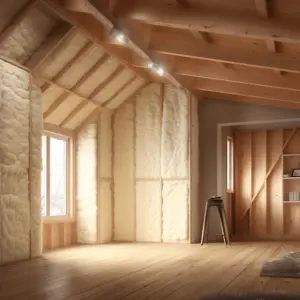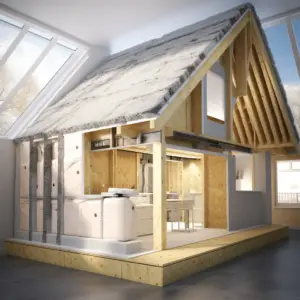Table of Contents
Understanding the Need for Energy-saving Insulation
Energy-saving insulation is essential. We need it to preserve energy and save on costs. It creates a barrier that keeps hot air out in summer and traps warmth inside in winter.
It doesn’t just regulate indoor temperatures; it also improves air quality, blocking dust, pollen, and allergens. Plus, it reduces noise transmission between rooms and from outside sources.
The US Department of Energy says proper insulation can save homeowners up to 20% on heating and cooling annually. This shows the power of energy-saving insulation for our wallets and the planet.
Different Types of Energy-saving Insulation

Insulation is a must to conserve energy and lower heating/cooling costs. Different types of energy-saving insulation materials are available for home-owners to choose from, based on their needs.
For example, Fiberglass Insulation consists of fine glass fibers packed together for great thermal insulation. Spray Foam Insulation expands when sprayed, creating an airtight seal and blocking moisture and mold. Cellulose Insulation, made from recycled paper/plant fibers, is fire-retardant and eco-friendly.
Other alternatives include Rigid Foam Insulation boards for foundations, exterior walls or concrete slabs, and Radiant Barrier Insulation to reflect heat away from the living space.
To maximize effectiveness of any insulation material, it’s essential to:
- Seal air leaks with caulk/weatherstripping.
- Ensure proper installation (hiring a professional helps).
- Add extra insulation in key areas (attics, basements, crawl spaces).
By following these tips, home-owners can up their home’s energy efficiency, lower utility bills and enjoy a comfy living environment.
Benefits of Energy-saving Insulation
Energy-saving insulation offers a plethora of benefits. Such as:
- Lower utility bills
- Enhanced comfort
- Improved indoor air quality
- Promotion of environmental sustainability
It also defends against moisture damage and boosts the longevity of buildings. It acts as a shield to stop heat loss in winter and heat gain in summer, leading to massive energy savings.
In the 1970s, during the oil crisis, energy-saving insulation was widely used for the first time. Prices of energy surged, which prompted the invention and utilization of insulation techniques to reduce energy consumption. This pivotal milestone opened the door for further progress in insulation technology and set the stage for more sustainable building practices.
Insulation so great, even your ice cubes will be jealous of the warmth in your home!
Factors to Consider when Choosing Energy-saving Insulation
Choosing the right energy-saving insulation needs careful thought. Six points to keep in mind are:
- Material: Select one with R-values and properties for your climate.
- Installation: Get experienced professionals for a proper fit and minimal air leakage.
- Cost: Look for the upfront cost and long-term savings.
- Eco-friendliness: Choose recycled or natural fibers for sustainability efforts.
- Maintenance: Check the maintenance needs of the insulation.
- Noise reduction: Pick one with good acoustic properties to reduce noise.
Also, think of other factors like fire resistance, moisture control, and compatibility with HVAC. This helps get optimal performance. Talk to a professional who knows energy-efficient building for informed decisions.
Pro Tip: Save money on insulation by using your frozen heart!
Cost-effectiveness of Energy-saving Insulation
Energy-saving insulation brings many cost-effective advantages. It traps heat in winter and keeps it cool in summer, leading to lower energy bills. Long-term savings are substantial, plus you can get incentives and rebates. The resale value of your property also increases!
Plus, it reduces carbon emissions and contributes to sustainability. In the early 2000s, there was skepticism about its efficacy and affordability. Studies and success stories then showed significant energy savings. Now, people and businesses embrace it!
It’s like giving your home a cozy sweater – minus the embarrassing holiday patterns!
Tips for Properly Installing Energy-saving Insulation
To maximize energy efficiency in homes and buildings, it’s vital to install energy-saving insulation properly. Here is a step-by-step guide to help you:
- Assess your needs. Identify areas requiring insulation – such as attics, walls, or floors. Consider factors like climate and budget.
- Choose the right type. Look at R-value, durability, and fire resistance. Common options include fiberglass batts, cellulose, and spray foam.
- Prepare the area. Remove existing insulation and seal gaps/cracks.
- Install carefully following manufacturer guidelines. Start from corners/edges, working towards the center. Maintain ventilation if using vapor retardants.
Safety gear (gloves, goggles, masks) is essential. Professionals may be needed for complex installations or if inexperienced. Regularly inspect for damage/wear. Monitor humidity levels for moisture-related problems.
By following these tips, energy-saving insulation can promote comfort and reduce bills. Maintain a well-maintained building envelope for even more energy savings.
Case Studies: Real-life Examples of Energy-saving Insulation
Insulation is key to saving energy in buildings. To give you an idea of its impact, let’s look at some examples! A residential house in New York City saved $800 per year. In Chicago, a commercial building saved $10,000 a month. Even hospitals benefit; a hospital in Los Angeles saved $50,000 per year.
These case studies show how effective energy-saving insulation can be. Here’s a tip: always consult with professionals when deciding on insulation methods. Their expertise will help you save money without sacrificing safety or comfort. Insulation: the best way to keep electricity bills low and s’mores hot!
Potential Challenges and Solutions in using Energy-saving Insulation
Insulating our homes is key for energy conservation. But, there are challenges and solutions to consider when using energy-saving insulation. Let’s go over these in detail.
We can look at the challenges and solutions using a table:
| Challenge | Solution |
|---|---|
| High initial costs | Government subsidies |
| Installation complexities | Professional assistance |
| Limited availability | Research and development |
| Retrofitting difficulties | Innovative insulation materials |
Now, let’s focus on some unique details. Building codes can push for energy-saving insulation. Incentives to contractors and homeowners will also help promote its use.
History-wise, energy-saving insulation dates back centuries. Ancient civilizations used natural materials like straw and mud to keep their homes warm. Today, we have advanced tech and materials to enhance energy efficiency.
By recognizing the challenges and applying the right solutions, we can overcome obstacles to using energy-saving insulation. This ensures a greener future for generations to come. Get ready to insulate your home with efficiency. Future trends in energy-saving insulation are here to slash your energy bill.
Future Trends in Energy-saving Insulation

Sustainability has become a hot topic, making it essential to explore future trends in energy-saving insulation. This not only reduces energy consumption, but also ensures a more comfortable living environment. Let’s take a look at some of the exciting developments in this area!
Nanomaterials are revolutionizing insulation. Lightweight and efficient, they possess remarkable insulating properties due to their nanoscale structure. This can be incorporated into various building components for enhanced thermal resistance.
Aerogels, known as “frozen smoke,” are incredibly lightweight materials with exceptional insulating capabilities. Mostly consisting of air, they are great for reducing heat transfer and can be used in windows and walls.
Phase Change Materials (PCMs) store and release large amounts of energy during phase transitions. Incorporating them into insulation systems can maintain a consistent indoor temperature throughout the day, while minimizing the need for heating or cooling.
Sustainable insulation materials made from renewable sources like recycled denim, cellulose, and sheep’s wool offer excellent thermal performance while reducing environmental impact.
Smart insulation systems adjust their thermal properties based on external conditions, improving energy efficiency. Plus, they allow for remote monitoring and control.
Biodegradable insulation materials made from natural fibers or plant-based polymers break down over time without harming the environment.
It is also important to consider details that haven’t been previously addressed. For instance, retrofitting existing buildings with energy-saving insulation can significantly reduce carbon emissions and energy costs. Additionally, collaborations between researchers, engineers, and architects are necessary for successful development and integration of these trends into mainstream construction practices.
To ensure energy savings and sustainable living, here are a few suggestions:
- Invest in retrofitting programs with financial incentives to promote wider accessibility.
- Educate consumers on the benefits of energy-saving insulation.
- Support research initiatives on insulation technologies.
- Strengthen building codes and implement policies that promote sustainable materials.
Following these suggestions will create brighter futures, where efficient energy-saving insulation plays a major role in reducing our carbon footprint. So, skip the gym and save on energy bills – let insulation do the heavy lifting for you!
Conclusion: The Importance of Energy-saving Insulation in Reducing Energy Consumption
Energy-saving insulation is key to reducing energy consumption. It keeps heat from escaping in winter and blocks out the heat in summer. This helps maintain a comfortable temperature, saving energy and lowering the carbon footprint.
Upgrading insulation in buildings can reduce energy needs for heating & cooling. This cuts down on electricity and fossil fuels, meaning less harmful emissions. So, energy-saving insulation fights climate change and encourages sustainable living.
Plus, proper insulation controls moisture, protecting the building and its occupants. It also offers economic and health benefits.
A family upgraded their home’s insulation and experienced a huge difference. They felt warmer in winter and cooler in summer without using too much heating or air conditioning. This saved them money and improved their quality of life.